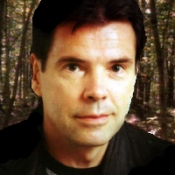 Michael A. Simpson, the Emmy and Peabody Award-winning filmmaker who helmed
Sleepaway Camp 2: Unhappy Campers and Sleepaway Camp 3: Teenage Wasteland
sat down to discuss these horror classics, through an exchange of e-mails
from his home in Los Angeles where he's partnered with his wife, Judy Cairo,
in a successful movie and television development and production company.
The cult director is open in discussing the movies, his background, and
the film making process.
Michael A. Simpson, the Emmy and Peabody Award-winning filmmaker who helmed
Sleepaway Camp 2: Unhappy Campers and Sleepaway Camp 3: Teenage Wasteland
sat down to discuss these horror classics, through an exchange of e-mails
from his home in Los Angeles where he's partnered with his wife, Judy Cairo,
in a successful movie and television development and production company.
The cult director is open in discussing the movies, his background, and
the film making process.
Sleepaway Camp Films: How did you get involved
as producer/director of the Sleepaway Camp sequels?
Michael Simpson:
I got involved through Double Helix Films. Double Helix optioned the sequel
rights from Robert Hiltzik, who all the camper fans know is the creator
of the original Sleepaway Camp. Jerry Silva, who was one of the producers
of the first Sleepaway Camp, was the CEO and Chairman of the Board of
Double Helix. Jerry knew Robert and negotiated the deal. So, happy campers,
Jerry came up with the idea of doing the sequels. The fans have him to
thank.
SCF:
And Double Helix asked you to direct the sequels?
Simpson:
Yes. They had previously asked me to serve on the board of directors of
their company which was in international distribution. I was the only
creative person on the board. The other folks were suits. Guys with ties.
SCF:
What attracted you to the projects?
Simpson:
The main thing other than a paycheck was a chance to try to stretch the
horror genre a bit and not do just another "dead teenager" movie.
I have a pretty dark sense of humor. Funland is a good example of that.
I wanted to find a way to express dark humor in a so-called "slasher"
movie. It's an idea you either love or hate. But for me, it was the only
way to go. The teen horror genre was already in danger of becoming a parody
of itself at the time so I figured, what the heck, call attention to it
and have some bloody fun.
SCF:
Humor with pop culture references in horror movies were not too common
at that time, although it's common today.
Simpson:
Yes. The SC sequels, in my opinion, really contributed to comedy loaded
with pop culture references being in horror films. I think that's one
of the reasons Kevin Williamson made reference to Angela in the script
for I Know What You Did Last Summer.
SCF:
Had you seen the original Sleepaway Camp before doing the sequels?
Simpson:
Yes. I watched the original Sleepaway Camp before I made my decision to
work on the sequels. It certainly has an ending people are always shocked
by. It's easy to see why it's gained such cult status. For me, the most
interesting part of the original story was I thought it provided a good
set-up for the transsexual aspects of Sleepaway 2 and 3.
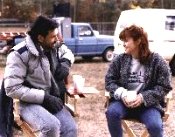 Michael and Tracy Griffith relax between scenes.
Michael and Tracy Griffith relax between scenes.
SCF:
In many cases with films, the writer is overlooked. Tell us a bit about
the screenwriter of the sequels, Fritz Gordon.
Simpson:
I first met Fritz through Michael Hitchcock.
SCF:
The guy credited for the Happy Camper Song?
Simpson:
Yes. I met Michael at the film festival in Park City, Utah, who saw a
screening of Impure Thoughts, liked it, and negotiated a deal to buy the
domestic video rights to it for Nelson Entertainment.
SCF:
Back to Fritz, how did he get involved with the Sleepaway sequels? What
is the genesis and development of the scripts he wrote?
Simpson:
After Double Helix secured the sequel rights, they negotiated a deal with
Nelson Entertainment to sell off the domestic rights to them in exchange
for the budget of the movies. Double Helix retained the international
rights which was where they made their profit. An executive at Nelson
wanted Fritz to write the sequels. At the time, Fritz was a beginning
screen writer.
SCF:
Ah. Mysterious. And what happened to Hitchcock?
Simpson:
Michael later did some great work with the Groundlings Comedy Troupe in
LA and has since written several movies including Where The Day Takes
You and House Arrest. Michael presently has a regular gig as a producer
and writer on Mad TV.
SCF:
The leap in terms of tone and character from Sleepaway Camp to Sleepaway
Camp 2 was a large one. Successful as it turned out, what was the catalyst
for the change?
Simpson:
A desire to do something different. At the time, the teen slasher genre
was thematically exhausted. It needed something else to keep it going.
Fritz Gordon has a warped sense of humor which he brought to writing the
sequels. I thought one of his best ideas was to have Angela actually go
under the knife and have a little snip, snip of her johnson. That's got
to be one of the most unique twists in the Sleepaway franchise.
SCF:
Were there any elements of the first film you would have liked to play
up? The Aunt Martha character comes to mind, an especially John Waters-esque
creepy/funny character.
Simpson:
Aunt Martha was a great, creepy character in the original. However, I
was pleased with what Fritz Gordon did with the sequel stories, especially
SC2. Doing any sequel is a tricky experience. It's sort of like sleeping
with another guy's wife or girlfriend. I know the sequels have a large
number of fans while some people love the original but not the sequels.
Some horror fans don't understand that the sequels are as much a parody
of the horror genre itself as a continuation of the original Sleepaway
Camp. On the other hand, many fans do get it and really like the sequels
as a result. So, if you're a horror fan, you either love or hate SC2 and
SC3. I think it comes down to the humor and whether you want some laughs
with your body count.
SCF:
You had quite a line-up of cast. The late Walter Gotell, Michael J. Pollard
etc. and fresh up-and-comers like Renée Estevez. How did you secure
them for the films?
Simpson:
We did casting in New York and Los Angeles for the leads. The other actors
were local to Atlanta. Shay Griffin did the Atlanta market casting. She
's absolutely one of the top casting directors around. She'd handled casting
on Impure Thoughts and Funland, and I knew she could find the right young
actors for the roles. I knew I wanted Renée for Molly the first
day I met her. I had lunch with her and her manager at a restaurant in
Westwood, close to the UCLA campus in LA. There's a sweet quality about
Renée that I thought would work for the character of Molly.
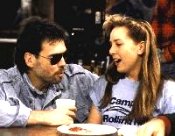 Michael with the lovely Renee Estevez.
Michael with the lovely Renee Estevez.
SCF:
How about adult Angela, Pamela Springsteen?
Simpson:
An agent I knew suggested Pamela for the role. When she read for me, she
infused this wonderfully bent quality into the character that I was looking
for. It just came to life right in front of me. I knew immediately she
was the one I wanted to play Angela. I stopped casting after that and
offered her the role the same day. Pamela is immensely talented. I really
liked working with her.
SCF:
Were there other contenders for the role?
Simpson:
We did casting in Atlanta, New York, and Los Angeles. There were twenty
or more other actresses I looked at before I read Pam. I remember Tracy
Griffith originally tried out for the part of Angela in New York, but
I felt she didn't have the right look. Of course, I ended up using her
in SC3 for the role of Marcia which was her feature film debut. I liked
Tracy's performance so much in SC3 that I used her as a starring lead
for my next film, Fast Food.
SCF:
It's commonly discussed that Pam is now a photographer.
Simpson:
Yes, Pamela is a professional still photographer in Los Angeles, much
in demand. She did the stills for Price of a Broken Heart, a movie our
company, Cairo/Simpson Entertainment, produced in '99 for Lifetime which
my wife Judy executive produced. I had a chance to see Pam then and she
was still her same sweet self. Her still photography is amazing. I have
a print of hers she gave me as a gift back in the 80's. I still have it
hanging in my home.
SCF:
It appears she gave up acting completely, then.
Simpson:
Regrettably, I don't believe Pamela pursues acting any longer. It's a
shame. She had a very natural way with her work. A transsexual, psychopathic
killer...boy, talk about going boldly where no one has gone before. There
aren't too many actresses who could have played that part as well as she
did. It would have been easy to be over-the-top and too broad or worse,
too dark and somber. She found the perfect balance.
SCF:
For our technical purists out there, were the films shot in 1.85:1 widescreen
or 1.33:1 full frame?
Simpson:
If memory serves me, they were shot 1.85:1. Bill Mills, the director of
photography for the sequels, would probably remember for sure.
SCF:
Why was there such a clampdown on the violence in SC3?
Simpson:
The MPAA. We ran into a problem with the Moral Police American A**wipes
on SC3. They got a fly up their nose about the Cindy death scene and also
the way Lilly, one of the camp counselors, died. As filmed, Cindy's death
was really gory. When Cindy got dropped from the flagpole and her head
smashed on the concrete, her brains splattered everywhere. We used pig's
brains and, believe me, it looked very real. The MPAA gave us an "X"
rating because of that scene so it had to be cut. Those folks have no
sense of humor or adventure.
SCF:
And Lilly's death you just mentioned?
Simpson:
Yes. That was another scene that contributed to the "X" rating.
We had this great shot of the lawn mover actually running over Lilly's
head. It had to be taken out. I was told it made one of the little old
ladies at the MPAA feel sick.
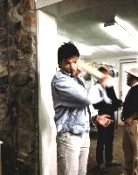 Even Michael's civilized attempts couldn't change
the minds of the MPAA.
Even Michael's civilized attempts couldn't change
the minds of the MPAA.
SCF:
Were the MPAA the only party poopers?
Simpson:
In SC2, remember when the happy campers are swimming in the pool? There's
a great shot of Valerie Hartman's very nubile character getting out from
the pool. As planned, you clearly see her nipples through her wet tee.
In the script there was a line which went something like, "Hey Emilio,
check out those nips." But the Georgia Department of Labor guys who
were on the set decided in their infinite wisdom that we couldn't have
a kid under the age of eighteen say the word "nips" so we changed
it to "Hey Emilio, party hats at two o'clock," or something
like that. The DOL boys didn't have a problem with that. For me it was
like, pardon my dust here folks, I'm just trying to get a movie made on
a budget. "Nips" to "party hats" ... these two DOL
guys were on the set for the entire shoot and that was their only concern
... it's always great to see your tax dollars at work.
SCF:
Let's backtrack. How did you get your start in the entertainment industry?
Simpson:
I graduated from the University of Georgia where I studied film and acting.
A piece of trivia for you. Wayne Knight, from Seinfeld and Third Rock,
was a student in the drama department at the time. Talk about a guy with
huge talent. After spending several years in Atlanta as a commercial and
documentary director, my first break came when I helped to develop two
television series for Turner Broadcasting.
SCF:
That's a surprise. What were those series?
Simpson:
Portrait of America was the first. The series was first developed in house
at Turner. Turner canceled the series after they'd spent several million
of Ted's hard earned dollars and hadn't managed to end up with anything
they could air. He decided to give it one more try but wanted the company
to go out of house to find someone to create it. Bill Mills, who later
was the director of photography on several of my features including the
Sleepaway Camp sequels, was working for Turner Broadcasting at the time.
He called me and got me to come in and talk with the Executive Producer
of the series. I ended up as a producer and director of Portrait of Georgia
which was the one-hour episode which became the template for the 60-episode
series. When Portrait of Georgia was televised, it won Emmys and as well
as Turner Broadcasting's first Peabody, which some people call "the
Pulitzer of broadcast journalism".
After that success, I also helped to create and
direct two seasons of another Turner Broadcasting series, World of Audubon.
During the time of this television work, I was business partners with
William VanDerKloot who's a talented commercial and documentary director
in Atlanta.
SCF:
Prior to the Sleepaway Camp sequels you directed several features.
Simpson:
Yes. My first feature was a movie called Impure Thoughts which was a small
art film that played at Sundance and got a theatrical release. It starred
Brad Dourif who horror fans will know from the Chucky series of movies.
SCF:
You got very good reviews for Impure Thoughts. Ed Blank of The Pittsburgh
Press called it "one of the funniest, gutsiest, most thoughtful and
lifelike movies of the '80s" when it was released theatrically. You
also did another movie, a comedy.
Simpson:
Yes. A very dark comedy, Funland, about Bruce Burger, an eccentric hamburger
franchise clown who's working the opening of an amusement park where a
local radio personality is trying to break the world's record for roller
coaster endurance. It was the first movie written by Bonnie and Terry
Turner. They went on to great success in Hollywood with the Wayne's World
movies and then the TV series Third Rock and That 70's Show. We wrote
Funland together. Bonnie and Terry are some of the most talented people
I have ever worked with. Fall down funny. I love them. Prior to the Sleepaway
Camp sequels, I'd also written and produced Dead Aim, a police thriller
starring Corbin Bernsen, Lynn Whitfield, Isaac Hayes and Ed Marinaro.
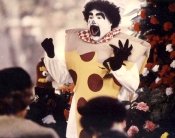 A scene from Simpson's film Funland.
A scene from Simpson's film Funland.
SCF:
You were still living in Atlanta at the time?
Simpson:
Yes. All those movies were shot in the Atlanta area.
SCF:
As well as the Sleepaway Camp Sequels.
Simpson:
Yes. At the time, Georgia was a very cost effective location for movie
making. Unfortunately, that's changed over the years.
SCF:
Word has it the budget for both films were one million dollars.
Simpson:
Yes, approximately, and that included insurance, completion bond and overhead
for Double Helix.
SCF:
Can you compare the two films?
Simpson:
SC2: Unhappy Campers works the best for me, both story wise and cinematically.
The fans seem to respond to Unhappy Campers the best also. SC3: Teenage
Wasteland was a bit rushed. We had very little preproduction time, essentially
one weekend, so it did not turn out as well. Also, I don't think the script
was as polished as Unhappy Campers was.
SCF:
So SC2 is your personal clear cut favorite of the two?
Simpson:
I had a great crew and cast on both movies so, overall, the production
of both movies was fun. The last few days of production of SC3 were pretty
tough. It turned very cold for Georgia in October and we were doing mostly
night scenes so we were all bundled up trying to stay warm. The budget
was wafer thin by that point also. Bob Phillips, the Unit Production Manager,
did a great job of helping to keep the train on the track. I also had
a great Director of Photography, Bill Mills, who knew how to shoot quickly.
All that helped. The hardest part for me was that I was the only producer
on the movies that actually knew how to produce one. Stan Wakefield and
Jerry Silva, the guys from Double Helix, were producers and executive
producers because their company was distributing the movie. But neither
of them understood or could contribute in any meaningful way to the production
process. So most of the line producing fell on my shoulders. That's tough
on such a low budget movie. Bob Phillips was a big help. I couldn't have
done them without his support.
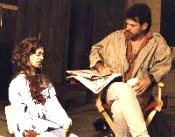
Michael chats with an executive from Double Helix
Films about his vision for the sequels.
SCF:
And how about you favorite scene?
Simpson:
One of my favorite scenes was in SC2. The abandoned cabin scene where
Molly finds Angela and they talk. I thought it was a bizarre little oasis
of intimacy in the midst of all the carnage. I felt you actually learned
something about Angela's character in that scene. In terms of gore, I
like the Brooke and Jodi barbecue scene in SC2. I thought that was tasty.
The power drill death for Mare was a nice one also. For SC3, Peter's firecracker
up the nose was pretty funny I thought. A great visual was Maria being
hit by the garbage truck. That was my favorite scene to film. I've also
always had a very warm spot in my heart for the drain cleaner down the
throat of the news reporter in SC3. It just seemed fitting somehow considering
all the things that had come out of and been put in her mouth.
SCF:
Did the sequel shoots end in a bang or a whimper?
Simpson:
The last day of production of SC3 was actually on Halloween that year.
It was a spooky, great way to end production of two horror movies. We
had a great wrap party.
SCF:
Tell us about what you do now and some of your recent projects.
Simpson:
My wife, Judy Cairo, and I have a development and production company based
in Los Angeles. We produce movies and television series. Jude's a well-regarded
and very talented television producer and executive producer. Beauty,
brains and talent...it's a hard package to resist. She's done a number
of movies for network and cable television.
I enjoy writing scripts the most these days.
 After SC3: Michael with Pam on the first day
of her Fast Food role.
After SC3: Michael with Pam on the first day
of her Fast Food role.
SCF:
How would you feel about being involved in future Sleepaways?
Simpson:
I haven't given it much thought. Robert has the rights to future sequels.
It'd be interesting to see what he does. Teen horror has changed so much
in the last 20 years. All the great horror franchises have either adapted
or wilted. Look at Jason, for instance. In his next film, it's set in
the future and Jason is in outer space! I wish Robert tons of luck if
he does another one. I know all the Sleepaway fans are eager to see what
Angela will do next and nobody knows Angela better than Robert.
SCF:
If you were going to do another one, what kind of direction would you
go in?
Simpson:
Good question. For me I think the most important thing would be to do
something off beat, something that isn't derivative. More than anything,
some fresh talent and blood would help the franchise get in touch with
today's audience I think.
In terms of story, "coloring outside the box"
as they say in LA would be a great way to go. Here's an example of what
I mean. One of the most original pitches I ever heard for a SC4 sequel
was SC4: Summer Stalk. A friend of mine, Randal Patrick, helped come up
with the basic idea. Camp Arawak had been demolished and a "summer
stock" (hence the play on words in the title) dinner theater had
been built on the site of the Sleepaway Camp massacres. The theater was
mounting a musical stage production of Angela's Life Story and Angela
(to be played by Felissa Rose) auditions to play herself. Only we, the
audience, aren't certain if this woman really is Angela who is now believed
to be dead. One of the fun parts to the story was that a religious cult
had grown up around the legend of Angela and they were trying to halt
the production of the play which they felt was sacrilegious to her memory.
These nut jobs were among those who believed Angela was dead so when the
killings start we aren't sure who is doing the murders. Is it these religious
kooks or Angela being her bad little transsexual psychopathic self again?
The whole story was sort of a poke in the eye with a very sharp stick
at the religious intolerance displayed by some among us which I always
find to be a fertile ground for parody. I wanted to show this story mainly
through the eyes of the woman who thinks she is Angela. She's been in
and out of mental hospitals and has lost touch with reality. She really
thinks she is Angela but is she? I felt a great way to twist this Angela
character into someone sympathetic was to have her haunted by her apparent
victims. You could have these zombie-like dead characters from the first
three movies popping up at the most importune moments, singing and dancing.
I thought the musical numbers should be surreal, like a demented version
of Rocky Horror.
The play within the SC4 movie was controversial
to this wacko cult because it explored the controversial "Two Angela"
theory. Namely, that two different young women had been Angela at different
times. At the climax of SC4 I thought it would be fun for Pamela Springsteen
to show up as Angela and have a fight to the death with Felissa Rose's
Angela. It would make the ultimate "camp" film I think. It would
be talked about for decades.
SCF:
Your sequels are directly responsible in creating the franchise and have
an absolutely huge fanbase. How does it feel?
Simpson:
It's all a little strange isn't it? These movies have taken on a life
of their own. I just hope the fans have as much fun watching them as we
did making them.
Thanks to Mike for taking time out of his schedule
to answer some burning questions!

